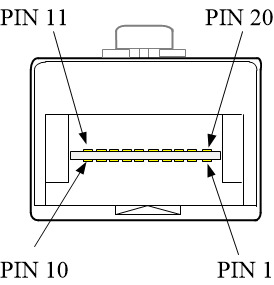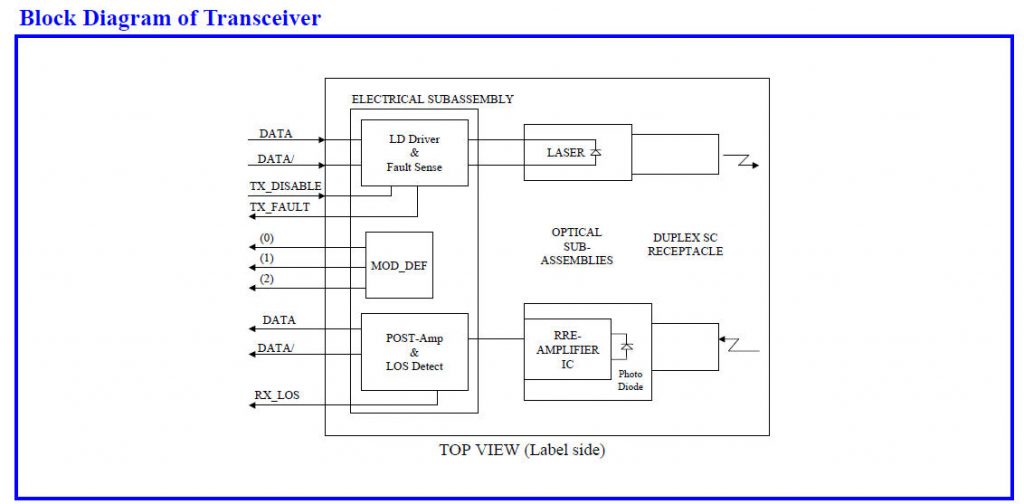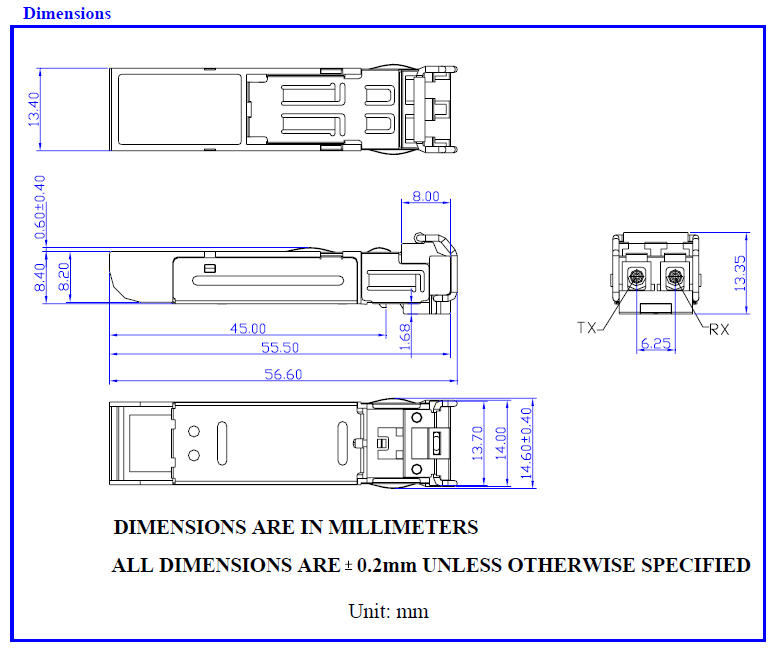Industrial SFP’s-Small Form Factor Pluggables with (Dynamic Management Interface)
(SFP) stands for Small Form Factor Pluggables – and is a compact, hot-pluggable transceiver used for both telecommunication and data communications applications.
The form factor and electrical interface are specified by a multi-source agreement (MSA) under the auspices of the S.F.P Committee.
Small Form Factor Pluggable interfaces network devices, for example switches, routers, media converters or similar device to a fibre optic or copper networking cable.
It is a popular industry format jointly developed and supported by many network component vendors.
The SFP transceivers are designed to support SONET, Gigabit Ethernet, 10Gbps Ethernet, Fibre Channel, and other communications standards. The word ‘Industrial’ indicates extended temperature operation, typically from -400C to +850C.
SFP’s are available with a variety of receiver and transmitter specifications. This allows users to select the relevant transceiver for each link to provide the required optical range over the available fiber type (e.g. multi-mode fibre or single-mode fibre).
Transceivers are also designated by their transmission speed. SFP modules are generally available in several different categories.
1 Gbit/s multi-mode fibre, LC connector, with black or beige extraction lever
- SX – 850 nm, for a maximum of 0.5km at 1.25 Gbit/s (Gigabit Ethernet). Other multi-mode SFP applications support even higher rates at shorter distances.
1.25 Gbit/s multi-mode fibre, LC connector, extraction lever colours not standardised
- SX+/MX/LSX (name dependent on manufacturer) – 1310 nm, for a distance up to 2 km. Not compatible with SX or 100BASE-FX. Based on LX but engineered to work with a multi-mode fibre using a standard multi-mode patch cable rather than a mode-conditioning cable commonly used to adapt LX to multi-mode.
1 to 2.5 Gbit/s single-mode fibre, LC connector, with blue extraction lever
- 1000BASE-SX –Near infrared (NIR) light wavelength. The standard specifies a distance capability between endpoints of 200m over 62.5 / 125 um fibre although in practice, with good quality fibre and terminations, 1000BASE-SX will usually work over greater distances. Modern 50/125um fibre can reliably extend the signal to 500m or more. This standard is popular for intra-building links large offices buildings. Typical optical power parameters of an SX interface are; maximum power -5dBm stressed receiver sensitivity = -14dBm
- LX – 1310 nm, 1000BASE-LX is a fibre optic Gigabit Ethernet Standard which uses a long wavelength laser (see IEEE 802.3 Clause 38), with a wavelength of 1270 to 1355nm and maximum RMS spectral width of 4nm. Typically GbE laser will be specified as having 1300nm or 1310nm wavelength
- EX – 1310 nm, for distances up to 40 km
- 1000 Base-ZX and 1000BASE-LH – 1550 nm-1000BASE-ZX and 1000BASE0LH are non standard but industry accepted terms to refer to Gigabit Ethernet transmission using 1550nm wavelength to achieve distances of at least 70 km over single-mode fibre
- EZX – 1550 nm, for distances up to 160 km (depending on fibre path loss)
- BX (officially BX10) – 1490 nm/1310 nm, Single Fibre Bi-Directional Gigabit SFP Transceivers. These are paired as BX-U (for Uplink) and BX-D (for Downlink) respectively, also for distances up to 10 km. Variations of bidirectional SFPs are also manufactured which use 1550 nm in one direction, and higher transmit power versions with link distances up to 80 km.
- 1550 nm XD 40 km , ZX 80 km , EX or EZX 120 km
- SFSW – Single Fibre Single Wavelength transceivers, for bi-directional traffic on a single fiber. Coupled with CWDM, these double the traffic density of fibre links
What is IEEE 802.3z?
IEEE Std 802.3z, extends the operating speed of local area networks to 1 billion bits per second (1000 Mb/s (1 Gbps)) for interconnecting high-performance switches, routers, and servers in the backbone of local area networks. Maintaining backward compatibility with the over-100-million-node installed base of 10 Mb/s and 100 Mb/s. A Key requirement of the standard was to be backwards compatible and to interwork with 10Mbps and 100Mbps.
What is DMI?
| Parameter | Symbol | Min | Max | Unit | Notes |
|---|---|---|---|---|---|
| Temperature monitor absolute error | DMI_Temp | -3 | 3 | Centigrade | Over operating temperature |
| Supply voltage monitor absolute error | DMI_VCC | -0.15 | 0.15 | Volt | Full operating range |
| RX Power monitor absolute error | DMI_RX | -3 | 3 | dB | |
| Bias current monitor | DMI_bias | -10% | 10% | mA | |
| TX power monitor absolute error | DMI_TX | -3 | 3 | dB |
DMI Stands for Dynamic Management Interface. It is a method of monitoring the fibre optic interface attached to the SFP’s.
The Dynamic Management Interface monitors transmit and receive levels, temperature and voltages and other critical parameters. More Information.
Gigabit SFP Fibre driver Models
| Part Number | Gigabit Ethernet | Fibre | Wave | Range | Max Tx Pwr | Min Rx Pwr | Download PDF |
| 885M-0.5D | IEEE 802.3z | Multi-Mode | 885nm | 0.5km | -4dBm | -18dBm | SFP-885-0.5D (1141 downloads ) |
| 1310nm SFP's | |||||||
| 813M-02D | IEEE 802.3z | Multi-Mode | 1310nm | 2km | -1dbm | -19dbm | SFP-813M-002D (1118 downloads ) |
| 813S-010D | IEEE 802.3z | Single Mode | 1310nm | 10km | -3dbm | -20dbm |
SFP-813S-010D (1113 downloads )
|
| 813S-020D | IEEE 802.3z | Single Mode | 1310nm | 20km | -2dbm | -23dbm | SFP-813S-020D (1064 downloads ) |
| 1550nm SFP's | |||||||
| 815S-030D | IEEE 802.3z | Single Mode | 1550nm | 30km | 30km | -21dbm | SFP-815S-030D (1081 downloads ) |
| 815S-050D | IEEE 802.3z | Single Mode | 1550nm | 60km | +1dbm | -24dbm | SFP-815S-050D (1133 downloads ) |
| 815S-070D | IEEE 802.3z | Single Mode | 1550nm | 70km | +5dbm | -24dbm | SFP-815S-070D (1031 downloads ) |
| 815S-090D | IEEE 802.3z | Single Mode | 1550km | 90km | +5dbm | -27dbm | SFP-815S-090D (1055 downloads ) |
| 815S-110D | IEEE 802.3z | Single Mode | 1550nm | 110km | +5dbm | -30dbm | SFP-815S-110D (1087 downloads ) |
| 815S-120D | IEEE 802.3z | Single Mode | 1550nm | 120km | +5dbm | -32dbm | SFP-815S-120D (979 downloads ) |
| 815S-140D | IEEE 802.3z | Single Mode | 1550nm | 140km | +5dbm | -34dbm | SFP-815S-140D (1050 downloads ) |
SFP Pin Orientation

SFP Pin Assignments
| Pin | Signal Name | Description |
| 1 | TGND | Transmit Ground |
| 2 | TX_Fault | Transmit Fault |
| 3 | TX_Disable | Transmit Disable |
| 4 | MOD_DEF(2) | SDA Serial Data Signal |
| 5 | MOD_DEF (1) | SCL Serial Clock Signal |
| 6 | MOD_DEF (0) | TTL Low |
| 7 | RATE SELECT | Open Circuit |
| 8 | RX_LOS | Receiver Loss of Signal, TTL High, open collector |
| 9 | RGND | Receiver Ground |
| 10 | RGND | Receiver Ground |
| 11 | RGND | Receiver Ground |
| 12 | RX- | Receive Data Bar, Differential PECL, ac coupled |
| 13 | RX+ | Receive Data, Differential PECL, ac coupled |
| 14 | RGND | Receiver Ground |
| 15 | VCCR | Receiver Power Supply |
| 16 | VCCT | Transmit Power Supply |
| 17 | TGND | Transmitter Ground |
| 18 | TX+ | Transmit Data, Differential PCEL ac coupled |
| 19 | TX- | Transmit Data Bar, Differential PCEL ac coupled |
| 20 | TGND | Transmitter Ground |
SFP Diagrams



